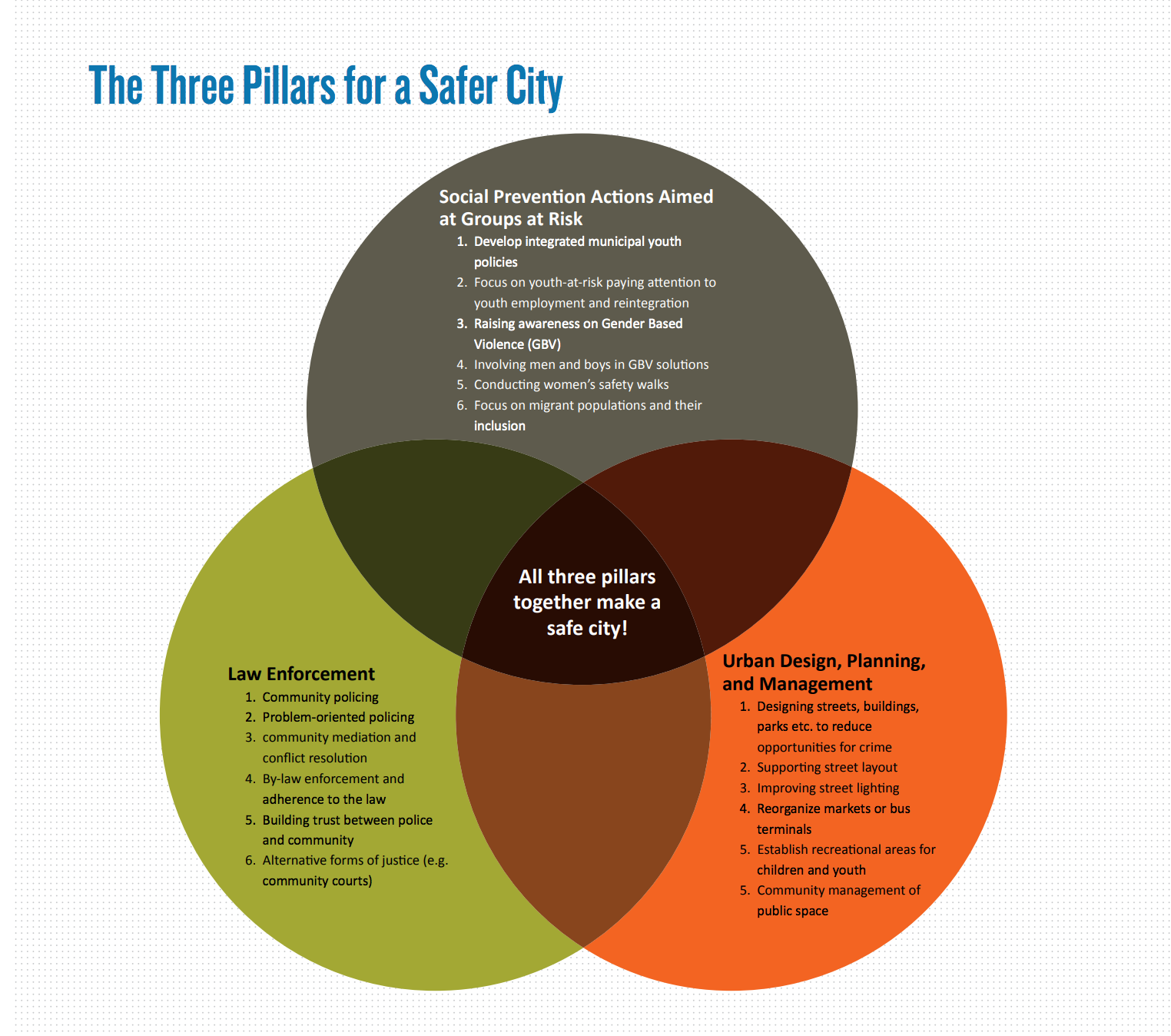This module is a resource for lecturers
United Nations entities
United Nations Habitat's Safer Cities Programme
UN-Habitat's Safer Cities Programme (hereafter, the Programme) was launched in 1996 to address urban crime and violence. The Programme supports a holistic, integrated, multi-level governmental and multi-sectoral approach to improving the liveability of cities and residents' quality of life. The Programme is underpinned by the belief that good urban governance, planning and management can greatly improve the safety of communities.

Figure 1: UN-Habitat's 3 Pillars for a Safer City (UN-Habitat, 2016, p. 19)
Approach to Crime Prevention
Developed in collaboration with cities from around the world, the programme rests on the premise that engaging vulnerable populations at all levels of planning and decision-making is fundamental to creating safer cities. The programme identifies the importance of implementing long-term solutions to social, economic and governance issues are implemented in cities, through policies that are inclusive of all members of society, especially vulnerable populations such as women, the urban poor, and at-risk youth.
Safer Cities Main Areas of Prevention
- Crime Prevention Through Environmental Design (CPTED): changing the physical environment can be a powerful means of reducing crime. It focuses on the effective management of public urban spaces and the activities that take place within them. Elements of the built environment, such as; street trading and markets, parking and public transport, street lighting and recreational areas can be reorganized in a way that will naturally enhance urban safety.
- Institutional Prevention: support for new and alternative forms of justice and policing with the aim of bringing criminal justice responses closer to the people. Examples may include community policing and alternative forms of conflict resolution led by traditional community leaders. Lecturers with an interest in alternative forms of conflict resolution may wish to refer to the Module 8 on Restorative Justice in this University Module Series.
- Social Prevention: actions and strategies aimed at helping people in vulnerable population groups. Such strategies may include trying to influence the underlying socioeconomic factors that expose certain populations to risk of engaging in criminal activity or becoming a victim of crime. Developmental crime prevention initiatives fall into this category, as well as initiatives to improve access to housing, education and employment.
Global Network on Safer Cities
The Global Network on Safer Cities (GNSC) is another initiative of UN-Habitat, introduced in 2012 to complement the work of the Safer Cities Programme. The GNSC endeavours to be the foremost international platform for crime prevention and the improvement of urban safety. It advocates for localized crime prevention strategies and acts as a platform to link existing crime and violence prevention networks with urban players.
The United Nations Crime Prevention and Criminal Justice Programme Network (PNI)
In conjunction with the Member States, the United Nations has formed a network of institutes located in various cities around world to assist the international community to address crime prevention and criminal justice at the global, regional and subregional levels. The network encourages active cooperation and collaboration of governments, academics, professionals and experts in developing crime prevention solutions that are appropriate and tailored to the target region. The institutions are also a place for information exchange, research, training and public education.
Below is a list of some of the region-specific crime prevention institutions in the PNI:
- United Nations Interregional Crime and Justice Research Institute (UNICRI) based in Italy
- United Nations Asia and Far East Institute for the Prevention of Crime and the Treatment of Offenders (UNAFEI) based in Japan
- United Nations Latin American Institute for the Prevention of Crime and Treatment of Offenders (ILANUD) based in Costa Rica
- European Institute for Crime Prevention and Control (HEUNI) based in Finland
- United Nations African Institute for the Prevention of Crime and the Treatment of Offenders (UNAFRI) based in Uganda
 Next:
Regional crime prevention councils / institutions
Next:
Regional crime prevention councils / institutions
 Back to top
Back to top